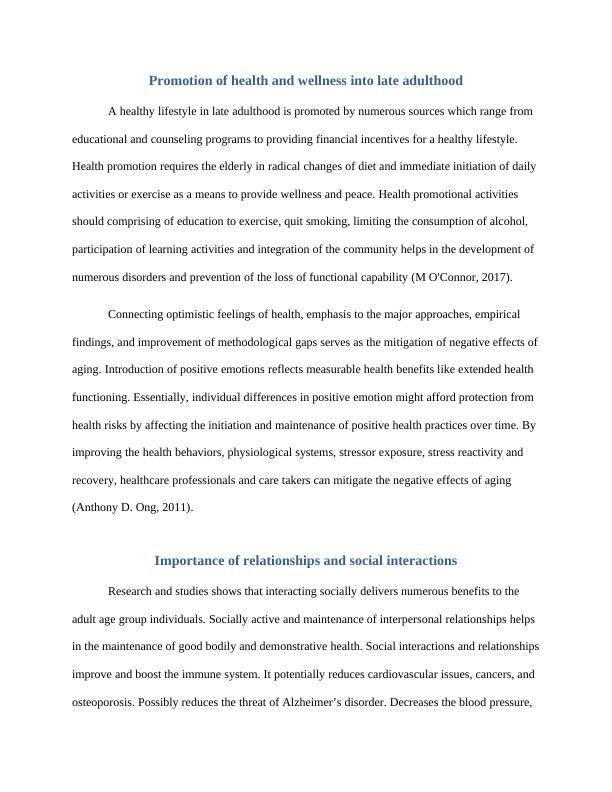Ageism and Stereotypes associated with Late Adulthood
Added on 2022-11-19
6 Pages1051 Words279 Views
Human Growth
Student Details:
Student Details:

Ageism and Stereotypes associated with late adulthood
Ageing is defined as a complex procedure which is highly individualized and continues
to be stereotyped. Stereotyping regarding a specific group reflects the procedure of interaction.
Stereotypes of aging comprises of generalizations and assumptions of about how people behave
and experience at certain age. Ageing stereotype could be positive or neutral in relation to health,
wealth and wise. Therefore, opinions of late old age, and the insights are compound,
multidimensional and vibrant. Additionally, stereotypes of ageing are communal concepts which
socially and traditionally located as well separately understood (AL Chasteen, 2015).
Physical changes
Some degree of atrophy of the brain and a decrease in the rate of neural processes, less
efficient circulatory and respiratory systems, increased constipation, diminished bone mass,
flexible skin, hair loss, decreased sensitivity.
Cognitive changes
Reduction of response speeds, decrease in working memory, intellectual changes,
reduction in fluid intelligence, crystallized intelligence and dementia.
Socio-emotional changes
Increased dependency in adulthood, feeling of guilt, shame, depression, loneliness,
connectivity and fear of confronting death which results in denial, anger, bargaining, depression,
and acceptance.
Ageing is defined as a complex procedure which is highly individualized and continues
to be stereotyped. Stereotyping regarding a specific group reflects the procedure of interaction.
Stereotypes of aging comprises of generalizations and assumptions of about how people behave
and experience at certain age. Ageing stereotype could be positive or neutral in relation to health,
wealth and wise. Therefore, opinions of late old age, and the insights are compound,
multidimensional and vibrant. Additionally, stereotypes of ageing are communal concepts which
socially and traditionally located as well separately understood (AL Chasteen, 2015).
Physical changes
Some degree of atrophy of the brain and a decrease in the rate of neural processes, less
efficient circulatory and respiratory systems, increased constipation, diminished bone mass,
flexible skin, hair loss, decreased sensitivity.
Cognitive changes
Reduction of response speeds, decrease in working memory, intellectual changes,
reduction in fluid intelligence, crystallized intelligence and dementia.
Socio-emotional changes
Increased dependency in adulthood, feeling of guilt, shame, depression, loneliness,
connectivity and fear of confronting death which results in denial, anger, bargaining, depression,
and acceptance.

Promotion of health and wellness into late adulthood
A healthy lifestyle in late adulthood is promoted by numerous sources which range from
educational and counseling programs to providing financial incentives for a healthy lifestyle.
Health promotion requires the elderly in radical changes of diet and immediate initiation of daily
activities or exercise as a means to provide wellness and peace. Health promotional activities
should comprising of education to exercise, quit smoking, limiting the consumption of alcohol,
participation of learning activities and integration of the community helps in the development of
numerous disorders and prevention of the loss of functional capability (M O'Connor, 2017).
Connecting optimistic feelings of health, emphasis to the major approaches, empirical
findings, and improvement of methodological gaps serves as the mitigation of negative effects of
aging. Introduction of positive emotions reflects measurable health benefits like extended health
functioning. Essentially, individual differences in positive emotion might afford protection from
health risks by affecting the initiation and maintenance of positive health practices over time. By
improving the health behaviors, physiological systems, stressor exposure, stress reactivity and
recovery, healthcare professionals and care takers can mitigate the negative effects of aging
(Anthony D. Ong, 2011).
Importance of relationships and social interactions
Research and studies shows that interacting socially delivers numerous benefits to the
adult age group individuals. Socially active and maintenance of interpersonal relationships helps
in the maintenance of good bodily and demonstrative health. Social interactions and relationships
improve and boost the immune system. It potentially reduces cardiovascular issues, cancers, and
osteoporosis. Possibly reduces the threat of Alzheimer’s disorder. Decreases the blood pressure,
A healthy lifestyle in late adulthood is promoted by numerous sources which range from
educational and counseling programs to providing financial incentives for a healthy lifestyle.
Health promotion requires the elderly in radical changes of diet and immediate initiation of daily
activities or exercise as a means to provide wellness and peace. Health promotional activities
should comprising of education to exercise, quit smoking, limiting the consumption of alcohol,
participation of learning activities and integration of the community helps in the development of
numerous disorders and prevention of the loss of functional capability (M O'Connor, 2017).
Connecting optimistic feelings of health, emphasis to the major approaches, empirical
findings, and improvement of methodological gaps serves as the mitigation of negative effects of
aging. Introduction of positive emotions reflects measurable health benefits like extended health
functioning. Essentially, individual differences in positive emotion might afford protection from
health risks by affecting the initiation and maintenance of positive health practices over time. By
improving the health behaviors, physiological systems, stressor exposure, stress reactivity and
recovery, healthcare professionals and care takers can mitigate the negative effects of aging
(Anthony D. Ong, 2011).
Importance of relationships and social interactions
Research and studies shows that interacting socially delivers numerous benefits to the
adult age group individuals. Socially active and maintenance of interpersonal relationships helps
in the maintenance of good bodily and demonstrative health. Social interactions and relationships
improve and boost the immune system. It potentially reduces cardiovascular issues, cancers, and
osteoporosis. Possibly reduces the threat of Alzheimer’s disorder. Decreases the blood pressure,

End of preview
Want to access all the pages? Upload your documents or become a member.
Related Documents
Psychosocial Development Theory by Eriksonlg...
|4
|760
|67
Development of Adulthood and Aging | Reportlg...
|9
|2116
|16
Music Interventions for Depression in Older Adultslg...
|8
|1979
|110
Maintaining Mental And Physical Healthlg...
|7
|1856
|20
Stroke: Impact on Life Stages and Healthcare Needslg...
|12
|1133
|125
Social Interaction and Healthy Aginglg...
|12
|2736
|44